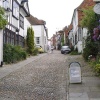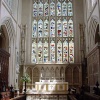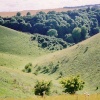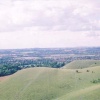Please login or click here to join.
Forgot Password? Click Here to reset pasword
 |  |  |  |  |  |
rustyruth Posts: 18773 Joined: 23rd Oct 2012 Location: England | quotePosted at 15:15 on 9th April 2015 OK, I could probably Google this and come up with a million answers, but the advice from the good people on POE is more reliable. I've had a set of six graduated colour filters bought, very nicely presented in a folding wallet. The question is, what do I do with them, well not so much what do I do with them, but what do I use them for, and in what conditions do I use each different colour ? I notice only half the lens is coloured too !! They are in the following colours, roughly. Red, Orange, Green, Yellow, Purple and Grey. Thanks. |
| Dave John Posts: 22335 Joined: 27th Feb 2011 Location: England | quotePosted at 19:07 on 9th April 2015 First of all are they round threaded filters or are they square plastic filters. If they are square you will need to ascertain whether Type A or Type P which simply refers to the width as you will need to buy a specific 'holder' which the attaches to the filter thread on the lens and allows the filters to slide up and down However I feel that in general the only one that coild be be of use, depending on it's strength, or opacity, would be the grey. Also does it have a 'hard' or 'soft' gradation in the middle The grey can be used to tone down particularly bright areas such as skies. So you would have to take your metering from the ground and let the grad take care of the sky.This might be a problem if the filters are round as the graduation blend really needs to coincide with the horizon / sky level which more often than not is NOT in the middle of the frame which is ewhere the grad blend will be. Whereas the square filters slide up and down in the mount to suit the brighter areas. You will find that landscape photographers in particular will have a selection of 'grads' in various strengths and blends, some times using more than 1 together to get the result they want The coloured ones I would consider more fun (artistic??) than anything else as they simply add their colour to whatever area of the image they are covering. For instance the GREEN would give you an odd looking sky with green clouds. I'm sure more ideas will follow from the rest of the folk here but on a purely personal level I would not really be interested in using the coloured ones, other than to create wacky coloured images so well worth playing with simply for fun |
rustyruth Posts: 18773 Joined: 23rd Oct 2012 Location: England | quotePosted at 19:31 on 9th April 2015 Thanks for the reply Dave. I should have provided more info really. They are round and they screw onto the 52mm kit lens that came with the camera. I've just had a look through them out of the window looking at the sky and the graduation in the middle appears to be soft. They're from a company called Xcsource and they appear to be glass, without bashing them too hard it's a bit difficult to tell. I'm almost certain they came from Amazon. The red one does make the sky look quite nice.
|
| Dave John Posts: 22335 Joined: 27th Feb 2011 Location: England | quotePosted at 20:57 on 9th April 2015 Probably did originate from Amazon. Xcsource is a Hong Kong based outfit with prices shown in $ |
| Vince Hawthorn Posts: 12758 Joined: 19th Apr 2010 Location: UK | quotePosted at 22:09 on 9th April 2015 Not a world I have delved into Ruth, especially the coloured ones, they would probably be a five minute wonder for fun. I have often thought about the graduated ones as the blown sky often does my head in, but up to now all the kit lenses have a rotating front lens which makes the grad filters no good -or indeed makes the use of the polarising filter a right game. Since getting my new lens at last with no rotating front lens the use of filters becomes a possabillity. ( Do check Ruth if your lens rotates at the front ). |
| Dave John Posts: 22335 Joined: 27th Feb 2011 Location: England | quotePosted at 22:20 on 9th April 2015 I remember when Jean Cokin first intoduced the square plastic filters, way back in the late 70's or early 80's I think, one of the most popular grads was known as 'tobacco' and was massiveley used to enhance skies. But for anyone seriously into landscapes the square (realistically oblong!!) style of filters and holders would be a money well spent. But yet again to get the optimum results with you really need to be using a tripod in order to ensure the correct orientation of the grad stays where you want it |
| Dave John Posts: 22335 Joined: 27th Feb 2011 Location: England | quotePosted at 22:31 on 9th April 2015 On 9th April 2015 19:31, rustyruth wrote:
Just a small point Ruth, the blend may seem soft looking through the filter but the delineation between soft and hard will change depending on lens aperture selected. At f4 - f5.6 will be fairly soft but stop down to f11 - f16 and you will notice a marked hardening of the blend |
| Rod Burkey Posts: 554 Joined: 2nd Sep 2008 Location: UK | quotePosted at 00:15 on 10th April 2015 I used Cokin graduated filters with my cameras loaded with slide film. They were used to add colour to skies mainly. At that time, many films on television had obvious use of graduated filters and they looked, in the main, rather obvious. If you can use graduated filters and end up with a natural or pleasing result fine, but mostly I failed in this, and the filters were left in drawers rather than in my camea bag. Now, I can use Photoshop to add graduated effects in a much more subtle way. If I don't like the result I can delete the file and or revert to the original RAW or DNG. An effect gained with a graduated filter is rather more permanent. There are endless pieces of kit available,including filters and other "must have" accessories, which maybe will empty bank accounts far more efficiently than adding quality to photographic results. |
| Edward Lever Posts: 734 Joined: 22nd Dec 2005 Location: UK | quotePosted at 10:20 on 10th April 2015 Graduated filters are potentially useful for reducing over-exposure in the sky, which frequently happens when taking landscapes with a uniformly cloudy sky. Such skies are unfortunately a feature of our climate. Taking an exposure reading off the scenery will result in a 'whited out' sky which can look unnatural. Even though I can see the logic of using a graduated filter, I prefer to juggle the exposure settings to get an acceptable compromise with the RAW file, and tweak later, as Rod suggests. I prefer to travel light when out photographing, and if I were to seriously use a graduated filter, I would probably need to bring a tripod as well. |
rustyruth Posts: 18773 Joined: 23rd Oct 2012 Location: England | quotePosted at 21:12 on 10th April 2015 Many thanks for all the wonderful replies. Lots of good info and advice as usual. I think I'll probably have a play around with them and see what results I get, I can see they might end up on the "seemed like a good idea at the time" pile, but they were a gift so I supppose I can't complain. Something else to go in the bag !!! I've not actually had them attached to the camera yet, the only looking though I've done is hand held. Two weeks in Cornwall at he end of the month with probably be the ideal place to try them out. If some strange coloured pictures appear on here they will be mine. Thanks again everyone, much appreciated.
|